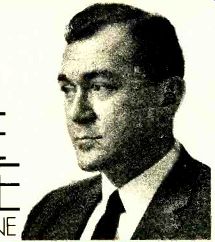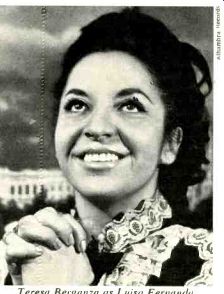
by WILLIAM LIVINGSTONE
MY SUMMER VACATION
Music lovers in New York, particularly opera fans, used to get a little time off in the summer. The Metropolitan and the New York City Opera Company would end their seasons in the spring, and we could spend free evenings putting our record collections in order and maybe even get away to the beach for a few weeks. No more! The "season" now seems never to end. New opera-producing companies keep springing up, and we get occasional visitors from elsewhere ( Moscow's Bolshoi Opera is already poised to spring at us). And with the continuing decentralization of the performing arts in this country there are more frequent and more tempting productions to lure opera-philes to such places as Santa Fe, Houston, Seattle. and Boston.
Shortly after the end of the Met season this year, Sarah Caldwell, artistic director of the Opera Company of Boston, had large number of fans traveling up from New York for America's first staged production of Berlioz's Benvenuto Cellini. Jon Vickers sang the title role, and other principals were Patricia Wells. Nancy Williams, Gimi Beni. Donald Gramm, and John Reardon. Miss Caldwell mounted and conducted the work herself, and I was most impressed by her ingenious staging, which included the casting of Cellini's famous statue of Perseus before our very eyes.
The production was an important event in the current revival of French opera and was well worth the trip to Boston. But, despite Miss Caldwell's clever direction, Benvenuto Cellini did not work for me as a theater piece (dramatic construction was not Berlioz's long suit). There is some wonderful music in it, however, and it was fun to hear familiar bits from the Roman Carnival Overture sung. The performance was in English, and English so well projected that one could follow the complicated plot easily. This made me wonder whether, given the current shortage of French singers, it might not be wise to do certain other French operas in translation.
Back in New York, I was still turning this thought over in my mind when I went to a performance of Ravel's opera-ballet L'Enfant et les Sortileges (The Spellbound Child) in the New York City Ballet's festival celebrating the Ravel centennial. The sets and costumes were beautiful, the choreography was by George Balanchine (he had worked with Ravel on the premiere), and it was conducted by Manuel Rosenthal (he studied with Ravel).
But somehow L'Enfant et les Sortileges didn't come off well as a theater piece either. Since the characters include an armchair, a teacup, a clock, assorted animals, and arithmetic (I am not making this up). all except The Child were portrayed on stage by dancers and were sung (English again) by singers off to one side.
This was something of a strain on the audience, and anything that has a child performer in it (in this case boy-soprano Paul Offenkrantz) is already in big trouble as far as I'm concerned. L'Enfant is a fascinating work musically, and it lasts only about forty minutes, but in the theater it seemed at least twice that long. And even the English didn't help.
Well, if I'm of two minds about opera in English in the theater, at least I know that on records I want the original language. And although Benvenuto Cellini and L'Enfant et les Sortileges are difficult to stage convincingly, they are fine on records. Fortunately, both are available in excellent performances in idiomatic French, Benvenuto Cellini on Philips and L'Enfant on London Stereo Treasury and Deutsche Grammophon. London offers a budget price, decent sound, and a delicate performance by a cast that includes Suzanne Danco conducted by Ernest Ansermet. For the full price on DG you get a more recent recording with up-to-date sound and a robust performance by Lorin Maazel. Both albums are recommendable.

----- Teresa Berganza as Luisa Fernando.
ANOTHER post-season vocal event was a repeat performance of Luisa Fernanda. a Spanish zarzuela, produced by Jose Bovantes and the Teatro Lirico Latino Americano. Bovantes, a Cuban impresario who has spiced up New York musical life for the past few years with such things as the return of Yma Sumac. staged Luisa Fernanda last year with regular members of his company. The cast I saw absolutely knocked me out--Puli Toro (as Luisa), Jorge Gavira, Antonio Barasorda, and Sara Escarpanter, a marvelous zarzuela singer of the old school with a glottal attack that would strip vocal gears not made of steel. Revived this year with the parents of Met tenor Placido Domingo-Placido Domingo Sr. and Pepita Embil--it went less well. Mme. Embil, a famous zarzuela singer who toured for years with her own company, no longer has the vocal resources to play the title role in Luisa Fernanda convincingly.
If you are not familiar with the Spanish operetta form called zarzuela (after the royal palace in Spain where it originated), Luisa Fernanda is a good work to begin with. Composed by Federico Moreno Torroba, it is filled with attractive music, and there is an excellent recording on the Alhambra label conducted by Rafael Friihbeck de Burgos and starring Teresa Berganza.
Zarzuela music is no more profound than the average Broadway musical. Distinguished by a strong lyric impulse, it was written to move or amuse audiences, and Alhambra's zarzuela catalog is a treasure trove of proof that it can. The company is a branch of Spanish Columbia, which is in turn an affiliate of British Decca, which in this country is Lon don Records. Some of Alhambra's albums are performances conducted by Ataulfo Argenta that were formerly available on the London label. These include a highlights album called "Romanzas y Dtios de Zarzuelas." which is one of my favorite zarzuela records and a good sampler for beginners. It contains famous arias and duets performed by Berganza and Pilar Lorengar when they were very young, and by Manuel Ausensi, Carlos Munguia, and Ana Maria Iriarte, a unique older singer with an incredible low chest register.
I'VE only just begun to mine the gold of this catalog, but I've liked everything I've heard so far. This includes Los Gavilanes and La Leyenda del Beso (one disc each) with Angeles Gulin, La Dolorosa and Los Claveles (on one record) with Berganza and Placido Domingo. La Gran Via (one side) with Nati Mistral, and El Prijaro Azul with Montserrat Caballe. A brand-new item is a disc of tenor arias from zarzuelas sung by Placido Domingo, also a good sampler for beginners.
Alhambra records are produced for Spanish-speaking collectors, so some of them contain a complete libretto in Spanish only and others have no annotation at all. If you can't find them in your area, you can order directly from the company: Alhambra Records, 2214 West 8th Ct., Hialeah, Florida 33012. They will send a catalog to anyone who requests it. I look at that catalog and want everything in it. and if I have any free evenings this summer. I expect to spend them listening to zarzuela records.
==============
Also see:
CLASSICAL DISCS and TAPES -- THE MINNESOTA ORCHESTRA'S RAVEL The debut release on the Vox label whets the appetite, DAVID HALL; AMERICA'S MUSICAL HERITAGE: An ambitious three-volume entry in the Bicentennial sweepstakes, PAUL KRESH